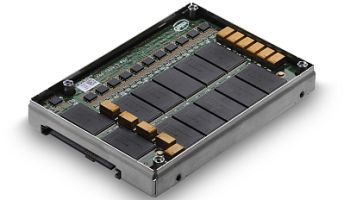Hitachi’s global storage division, needing to find a way to keep up with the constant advances in NAND flash at competitors such as Toshiba, Samsung, Micron, SanDisk and Seagate, has introduced a new line of MLC (multi-level cell) solid-state disks for enterprise systems.
The Ultrastar SSD400M drives, which use Intel’s 25-nanometer high-endurance NAND flash, come in a 2.5-inch form factor with a 6Gb SAS interface in capacities of 200GB and 400GB. They are designed to serve as the so-called Tier 0 layer for high-transaction-type applications.
The announcement was made at the annual Flash Memory Summit at the Santa Clara Convention Centre.
Tiered Storage For Optimisation
 Tier 1 storage, also known as production storage, usually consists of high-speed SAS (serial-attached SCSI) hard drives and is considered the primary tier for production data. Tier 2 and Tier 3 storage tiers (generally consisting of slower, cheaper SATA – or serial ATA – drives) handle non-critical data that does not require the speed of Tier 1 storage. Some archiving is done at the Tier 3 level.
Tier 1 storage, also known as production storage, usually consists of high-speed SAS (serial-attached SCSI) hard drives and is considered the primary tier for production data. Tier 2 and Tier 3 storage tiers (generally consisting of slower, cheaper SATA – or serial ATA – drives) handle non-critical data that does not require the speed of Tier 1 storage. Some archiving is done at the Tier 3 level.
Tier 0 is SSD-based storage used to improve performance beyond what current Tier 1 storage can offer for selected applications, such as financial services, retail sales, and others. Early on, Tier 0 storage has consisted of a RAM disk, which is more expensive than NAND flash. NAND flash is moving quickly into this space.
Ultrastar SSD400M 400GB features write endurance of 7.3 petabytes (PB) lifetime random writes, Hitachi said, which equates to 10 full drive writes per day for five years. The new multi-level SSDs also include all of the enterprise features found in the company’s front-line Ultrastar single-level cell (SLC) drives, such as end-to-end data protection, error correction and error handling, Hitachi said.
“Tier 0 enterprise applications are of increasing importance as more and more IT managers are redesigning their data centres for improved total cost of ownership, and to support advances in cloud computing, virtualisation and thin provisioning,” said Joseph Unsworth, research director of NAND Flash and SSD at Gartner.
“The insatiable desire for data is challenging storage ecosystems to deliver high-performance access to information while controlling data centre costs,” said IDC SSD research manager Jeff Janukowicz. “The introduction of MLC-based SSDs, such as Hitachi GST’s Ultrastar SSD400M, helps foster the market as it lowers SSD acquisition costs while still delivering the enterprise performance and reliability for which many IT managers desire in traditional enterprise storage and cloud computing environments.”
Hitachi GST is now shipping, and the company is currently qualifying its Ultrastar SSD400M drives with select OEMs. Broader qualification samples are now available with channel distribution scheduled in September, Hitachi said.




